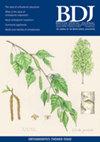Symptomatic irreversible pulpitis and other orofacial pain: overcoming challenges in diagnosis and management
IF 2
4区 医学
Q2 DENTISTRY, ORAL SURGERY & MEDICINE
引用次数: 0
Abstract
Due to the unique sensory innervation of the teeth and face, orofacial pain can be challenging to diagnose and manage. Odontogenic pain, or ‘toothache'', is the most common orofacial pain condition and encompasses the vast majority of pain which is presented to dental practitioners. While diagnosis is often straightforward, the clinical picture is occasionally unclear or contradictory, and in these situations, the clinician should be able to consider reasons other than the teeth for the patient''s presenting complaint. The primary aim of managing odontogenic pain is to treat the underlying cause, often arising from the dental pulp or periapical tissues; however, several factors can make pre-, intra- and post-operative management of odontogenic pain challenging. This paper will consider key similarities and differences in the clinical presentation of odontogenic pain and other non-odontogenic causes of orofacial pain in order to help practitioners arrive at the correct diagnosis. We discuss evidence-based recommendations for intra- and post-operative management of acute odontogenic pain, and consider the underlying neurophysiological features which make orofacial pain challenging to manage.

有症状的不可逆牙髓炎和其他口面部疼痛:克服诊断和管理方面的挑战
本文章由计算机程序翻译,如有差异,请以英文原文为准。
求助全文
约1分钟内获得全文
求助全文
来源期刊

British Dental Journal
医学-牙科与口腔外科
CiteScore
3.10
自引率
15.40%
发文量
1096
审稿时长
4-8 weeks
期刊介绍:
The role of the BDJ is to inform its readers of ideas, opinions, developments and key issues in dentistry - clinical, practical and scientific - stimulating interest, debate and discussion amongst dentists of all disciplines. All papers published in the BDJ are subject to rigorous peer review.
 求助内容:
求助内容: 应助结果提醒方式:
应助结果提醒方式:


